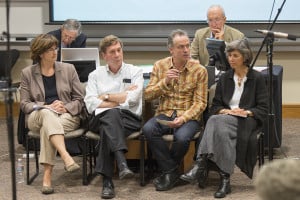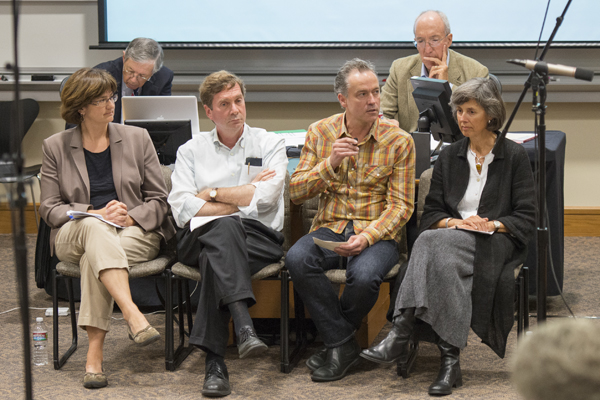
The Faculty Senate discussed the increasing number of units required for undergraduate majors, and the rising percentage of Stanford students graduating with more than the required 180 units, at its first meeting of the academic year.
Senate Chair Raymond Levitt, professor of civil and environmental engineering, opened the meeting by welcoming the new Senate — which includes 12 new members — and citing the accomplishments of the body during the previous academic year, including the introduction of sweeping changes to freshman requirements.
Senior Associate Vice Provost of Undergraduate Education Martha Cyert then opened the meeting’s agenda by presenting a report on student workload in majors, which she framed as a logical development of research done by the Study of Undergraduate Education at Stanford (SUES).
“The SUES commission didn’t undergo direct review of the major, but [it] did raise various concerns about larger majors constraining student course choice,” Cyert said. “The purpose of this report is to launch a discussion and give us a starting point for further study.”
Discussing a report that focused largely on variations in the units required by different majors, Cyert acknowledged that relying on voluntary student responses in determining time spent per academic credit across majors offers limited accuracy.
According to this report, students enrolled in more technical majors see themselves as assuming a significantly greater workload per unit of credit. Federal regulations establish an academic credit as being two units of work outside of class. Mechanical engineering and computer science both breached a three-hour benchmark of outside coursework per unit.
“It’s clear that the two engineering majors do show significantly higher hours of work,” Cyert said.
The SUES report expressed concern that the potential for further growth in major requirements might infringe on freshman year’s freedom in course selection, but Cyert said few majors have changed significantly in the number of units required for graduation over the past 20 years.
Most majors, however, have only increased marginally in size, a trend matched by a gradual increase in the number of students graduating with more than 180 units of academic credit and a steadily rising number of students opting to pursue co-terminal degrees.
Kam Moler, professor of physics, opened a panel discussion of the report’s significance by exploring the physics department’s reduction in course requirements over time, which she framed as an effort to make the syllabus more accessible and in tandem with the evolution of graduates’ subsequent careers.
“We wanted the requirements to reflect what we thought a physicist should be,” Moler said, noting that many physics majors take additional courses within the department.
Brad Osgood, professor of electrical engineering, said the School of Engineering’s demanding major requirements were reflective of accreditation conferred on five of the school’s majors by the Accreditation Board for Engineering and Technology, which requires a year of math and science in addition to a year and a half of more in-depth engineering study.
By contrast, Gavin Jones, English Department chair, framed the English major’s relatively lenient requirements as the result of ongoing evaluation and soliciting student feedback.
“Departments should regularly and rigorously assess the size of their major,” Jones said. “Our unit count was the result of thinking from the ground up.”
Rosemary Knight Ph.D. ’85, professor of geophysics, concluded the panel discussion by defending the earth systems program’s onerous requirements — estimated by Cyert to approach 150 units — as the result of the program’s complexity, and cited a positive student response to the program’s extensive offerings.
“We’re trying to prepare students to deal with the complexity of real-world environmental problems,” Knight said. “[Students] are drawn to this multidisciplinary experience.”
Faculty discussion of the report’s finding focused on the relationship between unit counts and the work students assume as a result, with several senators inquiring whether majors’ higher unit counts were forcing students to sacrifice extracurricular pursuits or other interesting classes.
“We’re getting more and more petitions to take more than 20 units,” said Vice Provost of Undergraduate Education Harry Elam.
Eric Roberts, professor of computer science, argued that the student body’s transition over time to more technical majors had naturally led to a greater proportion of undergraduate students becoming enrolled in higher unit count majors.
“We don’t need to look for hard explanations if there’s an easy one staring us in the face,” Roberts said.
“If this is what students want, then we’re meeting those needs and there’s no problem to be solved,” said Mark Zoback M.S.’73 Ph.D. ’75, professor of geophysics.
Report on University information systems
The Senate then heard the annual report of the Committee on Academic Computing and Information Systems, delivered by Howard Zebker Ph.D. ’84, professor of electrical engineering, and Matthew Ricks, executive director of computing services.
Zebker focused on shortcomings in wireless infrastructure but noted successful — if disjointed — online education experiments as focal points for the committee’s discussion in the upcoming year. He discussed the increasing interchangeability between physical and virtual learning environments and students’ reliance on both.
“This is their communication medium, and we have to be aware of that,” Zebker said.
Ricks discussed the University’s current and potential use of cloud computing solutions for University services, such as the recent transition of undergraduate email and calendar services to Google.
“The challenge is [that] to use those services without contractual protection can put Stanford at risk,” Ricks said.
“By natural extension, [data protection legislation] applies to everything that happens in the Medical School,” said Andrew Fire, professor of pathology and genetics. “It’s very important to ensure the definition doesn’t extend beyond what truly is protected health information.”
The Senate will discuss online education, including a report by newly appointed Vice Provost for Online Learning John Mitchell, at its next meeting on Oct. 25.F
